Calf exports have now passed 70,000 head and are running some 10% ahead of last year. Demand in Holland has been strong. But the attention of the country’s seven major exporters will increasingly switch to sending stronger calves to Spain and Italy.
William O’Keeffe from Charleville, Co Cork, exports mostly to Holland and Spain. He buys most of them directly off farms across Munster as well as some mart sales.
He assembles the calves at the export lairage of Patrick Kelleher at Macroom, under the supervision of the Department of Agriculture, and exports them on the Rosslare to Cherbourg route.

This approved livestock truck owned by O’Brien Bros of Ballyorgan, Co Limerick has arrived to bring a consignment of calves to Holland. On arrival, the lorry’s tanks are filled with drinking water. This approved livestock truck owned by O’Brien Bros of Ballyorgan, Co Limerick, has arrived to bring a consignment of calves to Holland. On arrival, the lorry’s tanks are filled with drinking water.

The trailer is already cleaned out and disinfected. It will now be bedded with barley straw. As every farmer knows well, fresh, dry, cool air keeps calves healthy. The ventilation openings can be adjusted to regulate airflow depending on outside weather. Note the electric fans in the sidewalls – if the trailer is stationary and outside temperature is high they can be switched on to ensure flow of air. The trailer is already cleaned out and disinfected. It will now be bedded with barley straw. As every farmer knows well, fresh, dry, cool air keeps calves healthy. The ventilation openings can be adjusted to regulate airflow depending on outside weather. Note the electric fans in the sidewalls – if the trailer is stationary and outside temperature is high they can be switched on to ensure flow of air.
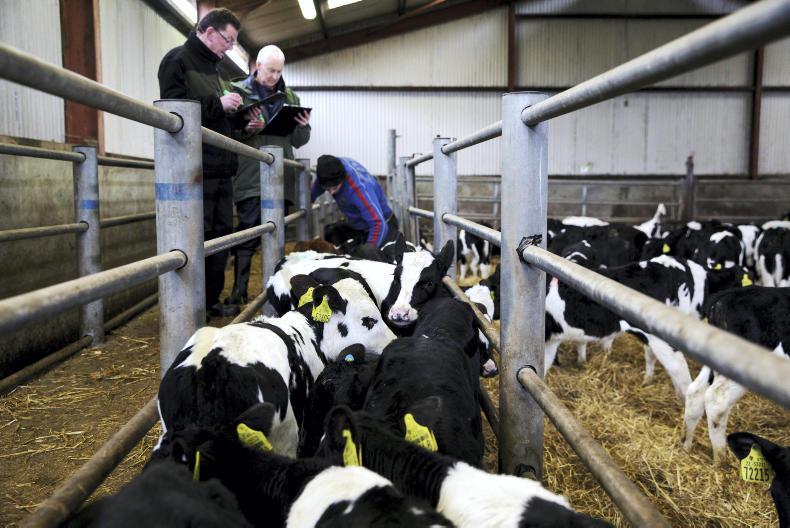
Export of livestock is tightly regulated and monitored by the Department of Agriculture to ensure identification, traceability, health and welfare. Here, Department officials Brendan Dunne and John Crowley check ear tags and passports, helped by Harry Morrissey.Export of livestock is tightly regulated and monitored by the Department of Agriculture to ensure identification, traceability, health and welfare. Here, Department officials Brendan Dunne and John Crowley check ear tags and passports, helped by Harry Morrissey.

The truck has been bedded and now the calves load, under Department supervision. The 45 foot long truck can hold about 300 calves on three decks, depending on their age and size.The truck has been bedded and now the calves load, under Department supervision. The 45ft long truck can hold about 300 calves on three decks, depending on their age and size.
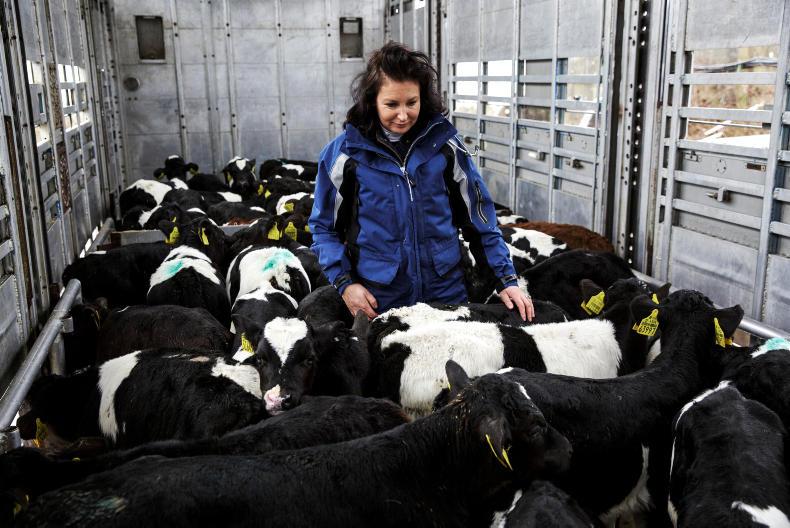
Department of Agriculture vet Maria Wall checks the calves for health, ear tags and any possible injury during loading.
Department of Agriculture vet Maria Wall checks the calves for health, ear tags and any possible injury during loading.

The calves have access to drinking water on the truck at all times.The calves have access to drinking water on the truck at all times.
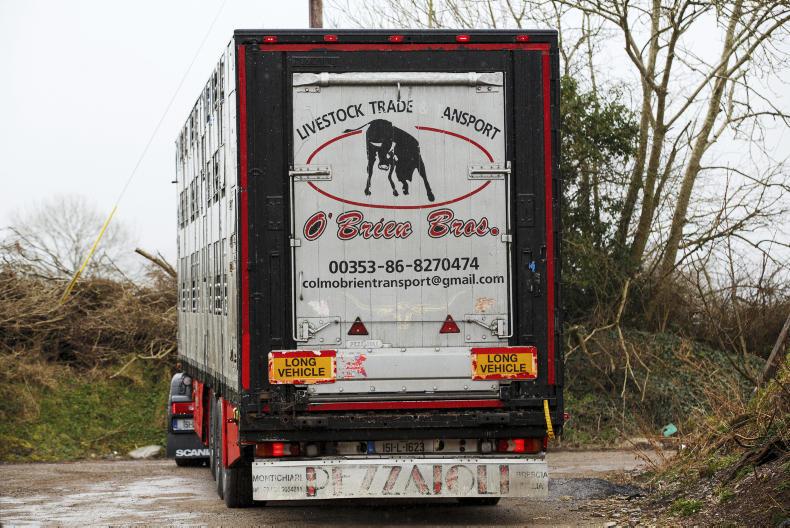
The lorry leaves the yard and heads for Rosslare. After arriving at Cherbourg the calves will unload, eat, drink and rest for 12 hours, in a lairage approved by French veterinary officials. On arrival in Holland they will be inspected by Dutch veterinary officials and will then enter veal feedlots. Dutch buyers require calves to be 100% healthy on arrival. The lorry leaves the yard and heads for Rosslare. After arriving at Cherbourg the calves will unload, eat, drink and rest for 12 hours, in a lairage approved by French veterinary officials. On arrival in the Netherlands they will be inspected by Dutch veterinary officials and will then enter veal feedlots. Dutch buyers require calves to be 100% healthy on arrival.
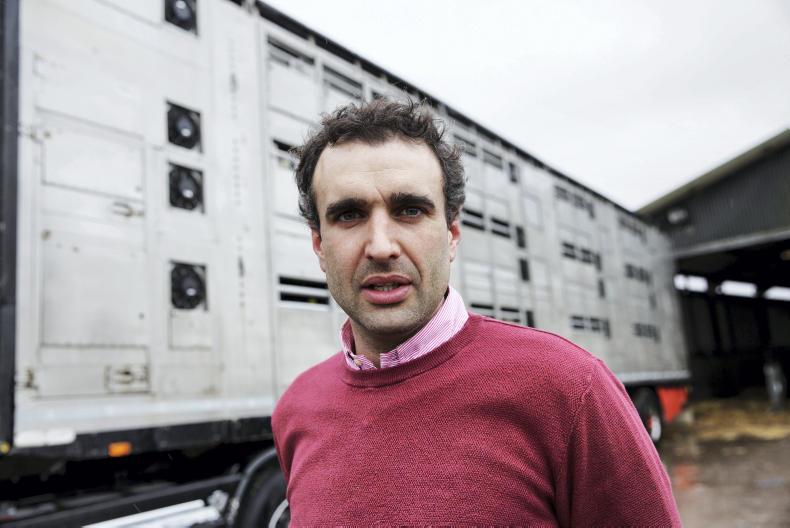
William O’Keeffe was initially involved in supplying calves to local farmers. Two years ago he decided to became involved in exporting. He flew the Netherlands, hired a car, drove around to a number of calf farms and feedlots and secured his first orders. William O’Keeffe was initially involved in supplying calves to local farmers. Two years ago, when Cork Marts quit calf exports, he decided to became involved. He flew to Holland, hired a car, drove to a number of calf farms and feedlots and secured his first order
Read more
Calf exports 16% above 2017 levels
Angus and Herefords back €70 to €90/head on last year
Calf exports have now passed 70,000 head and are running some 10% ahead of last year. Demand in Holland has been strong. But the attention of the country’s seven major exporters will increasingly switch to sending stronger calves to Spain and Italy.
William O’Keeffe from Charleville, Co Cork, exports mostly to Holland and Spain. He buys most of them directly off farms across Munster as well as some mart sales.
He assembles the calves at the export lairage of Patrick Kelleher at Macroom, under the supervision of the Department of Agriculture, and exports them on the Rosslare to Cherbourg route.

This approved livestock truck owned by O’Brien Bros of Ballyorgan, Co Limerick has arrived to bring a consignment of calves to Holland. On arrival, the lorry’s tanks are filled with drinking water. This approved livestock truck owned by O’Brien Bros of Ballyorgan, Co Limerick, has arrived to bring a consignment of calves to Holland. On arrival, the lorry’s tanks are filled with drinking water.

The trailer is already cleaned out and disinfected. It will now be bedded with barley straw. As every farmer knows well, fresh, dry, cool air keeps calves healthy. The ventilation openings can be adjusted to regulate airflow depending on outside weather. Note the electric fans in the sidewalls – if the trailer is stationary and outside temperature is high they can be switched on to ensure flow of air. The trailer is already cleaned out and disinfected. It will now be bedded with barley straw. As every farmer knows well, fresh, dry, cool air keeps calves healthy. The ventilation openings can be adjusted to regulate airflow depending on outside weather. Note the electric fans in the sidewalls – if the trailer is stationary and outside temperature is high they can be switched on to ensure flow of air.

Export of livestock is tightly regulated and monitored by the Department of Agriculture to ensure identification, traceability, health and welfare. Here, Department officials Brendan Dunne and John Crowley check ear tags and passports, helped by Harry Morrissey.Export of livestock is tightly regulated and monitored by the Department of Agriculture to ensure identification, traceability, health and welfare. Here, Department officials Brendan Dunne and John Crowley check ear tags and passports, helped by Harry Morrissey.

The truck has been bedded and now the calves load, under Department supervision. The 45 foot long truck can hold about 300 calves on three decks, depending on their age and size.The truck has been bedded and now the calves load, under Department supervision. The 45ft long truck can hold about 300 calves on three decks, depending on their age and size.

Department of Agriculture vet Maria Wall checks the calves for health, ear tags and any possible injury during loading.
Department of Agriculture vet Maria Wall checks the calves for health, ear tags and any possible injury during loading.

The calves have access to drinking water on the truck at all times.The calves have access to drinking water on the truck at all times.

The lorry leaves the yard and heads for Rosslare. After arriving at Cherbourg the calves will unload, eat, drink and rest for 12 hours, in a lairage approved by French veterinary officials. On arrival in Holland they will be inspected by Dutch veterinary officials and will then enter veal feedlots. Dutch buyers require calves to be 100% healthy on arrival. The lorry leaves the yard and heads for Rosslare. After arriving at Cherbourg the calves will unload, eat, drink and rest for 12 hours, in a lairage approved by French veterinary officials. On arrival in the Netherlands they will be inspected by Dutch veterinary officials and will then enter veal feedlots. Dutch buyers require calves to be 100% healthy on arrival.

William O’Keeffe was initially involved in supplying calves to local farmers. Two years ago he decided to became involved in exporting. He flew the Netherlands, hired a car, drove around to a number of calf farms and feedlots and secured his first orders. William O’Keeffe was initially involved in supplying calves to local farmers. Two years ago, when Cork Marts quit calf exports, he decided to became involved. He flew to Holland, hired a car, drove to a number of calf farms and feedlots and secured his first order
Read more
Calf exports 16% above 2017 levels
Angus and Herefords back €70 to €90/head on last year









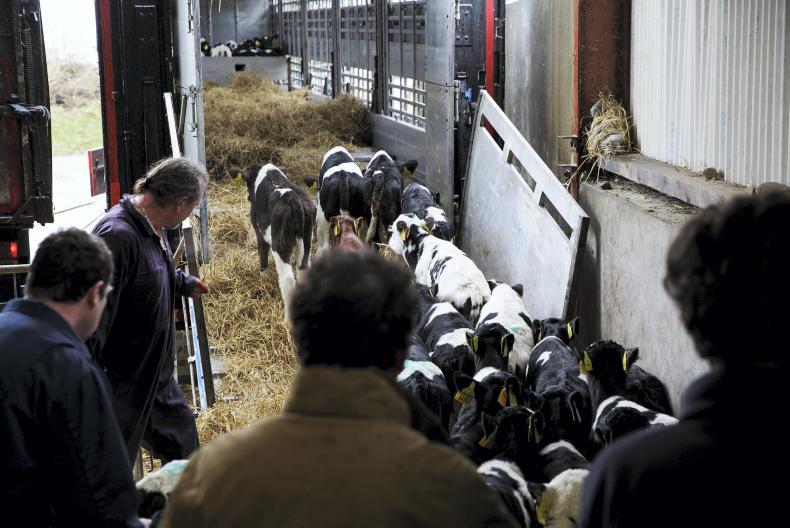




 This is a subscriber-only article
This is a subscriber-only article










SHARING OPTIONS: